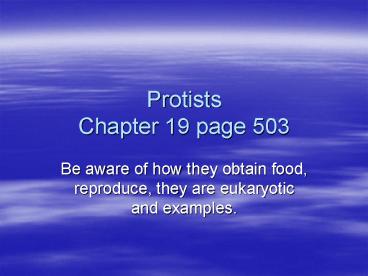Protists Chapter 19 page 503 - PowerPoint PPT Presentation
1 / 32
Title:
Protists Chapter 19 page 503
Description:
Protists Chapter 19 page 503 Be aware of how they obtain food, reproduce, they are eukaryotic and examples. 5 Kingdom System (Bacteria Monerans; 6 Kindgom System ... – PowerPoint PPT presentation
Number of Views:108
Avg rating:3.0/5.0
Title: Protists Chapter 19 page 503
1
ProtistsChapter 19 page 503
- Be aware of how they obtain food, reproduce, they
are eukaryotic and examples.
2
5 Kingdom System(Bacteria? Monerans 6 Kindgom
System?Archaebacteria and Eubacteria)
3
3 Characteristics
- 1-Eukaryotic
- 2-Most unicellular (some multicellular)
- 3- Heterotrophic, autotrophic, and some act as
decomposers
4
Plant-Like Protists
- CELL Uni/multicellular
- FOOD Autotrophic
- REPRO Asexual reproduction-no fusion of gametes
offspring identical to parent - MOVE flagella or cilia
5
A-Euglenas
- Unicellular
- Autotrophic
- Asexual
- Move with flagellum (in water)
- Contain chloroplasts and have an eye-spot
6
Euglena
7
B-Golden algae/Diatoms
- Unicellular cell wall
- Store food as oil
- Asexual
- Move with water movement
- When dead? shells used for glass, road paint
reflection and toothpaste
8
Diatoms
9
C-Dinoflagellates
- Multicellular
- Autotrophic
- Asexual repro
- Flagellum for movement
- Can glow in the dark, food source, red tide
10
Dinoflagellates
11
Dinoflagellates
- May cause Red Tide
Toxic for both fish and people.
?Notice the shell coverings
12
Green Algae Continued
Volvox
Spirogyra
13
Green Algae
14
Other plant-like protists Brown Algae
Food source for people-kelp.
15
Red Algae
16
- ANIMAL-LIKE PROTISTS
17
2-Animal-Like Protists
- CELL Unicellular
- FOOD Heterotrophs
- REPRO Asexually reproduce
- MOVE Classificed by movement?Move with cilia or
flagella
18
A-Ciliates
- Cilia
- Oral grooves to take in food
- Reproduce fission
19
Ciliates
- Paramecium (caudatum)
20
B-Flagellates
- Use flagellium
- What cell part will supply the energy for the
flagellum?
21
Flagellates
- Trypanosoma (causes
- African Sleeping Sickness)
- Carried by the tse tse fly
22
C-Amoeboids
- Also called sarcodines
- Have pseudopods- false-feet to capture food
(endocytosis)
23
Amoebas
- Moves with pseudopodia/false feet
24
Amoebas Their Relatives Foraminiferans
25
Amoebas Their RelativesRadiolarians
26
D-Sporozoa
- All parasites? feed on blood
- Move only by insects or animals
27
Sporozoans
- They cannot move on their own
- Plasmodium (vivax) is carried by mosquitoes
28
- PLANKTON
- AND FUNGUS-LIKE
- PROTISTS
29
3-Plankton/Fungus-like Protists
- CELL Multicellular
- FOOD Autotrophic
- grass of the sea? food!
- MOVE Most are not mobile (except by current)
- Produce lots of O2
30
Fungus-Like Protists
- Slime Molds
31
Fungus-Like Protists Continued
- Water Molds Downy Mildews
32
(No Transcript)































